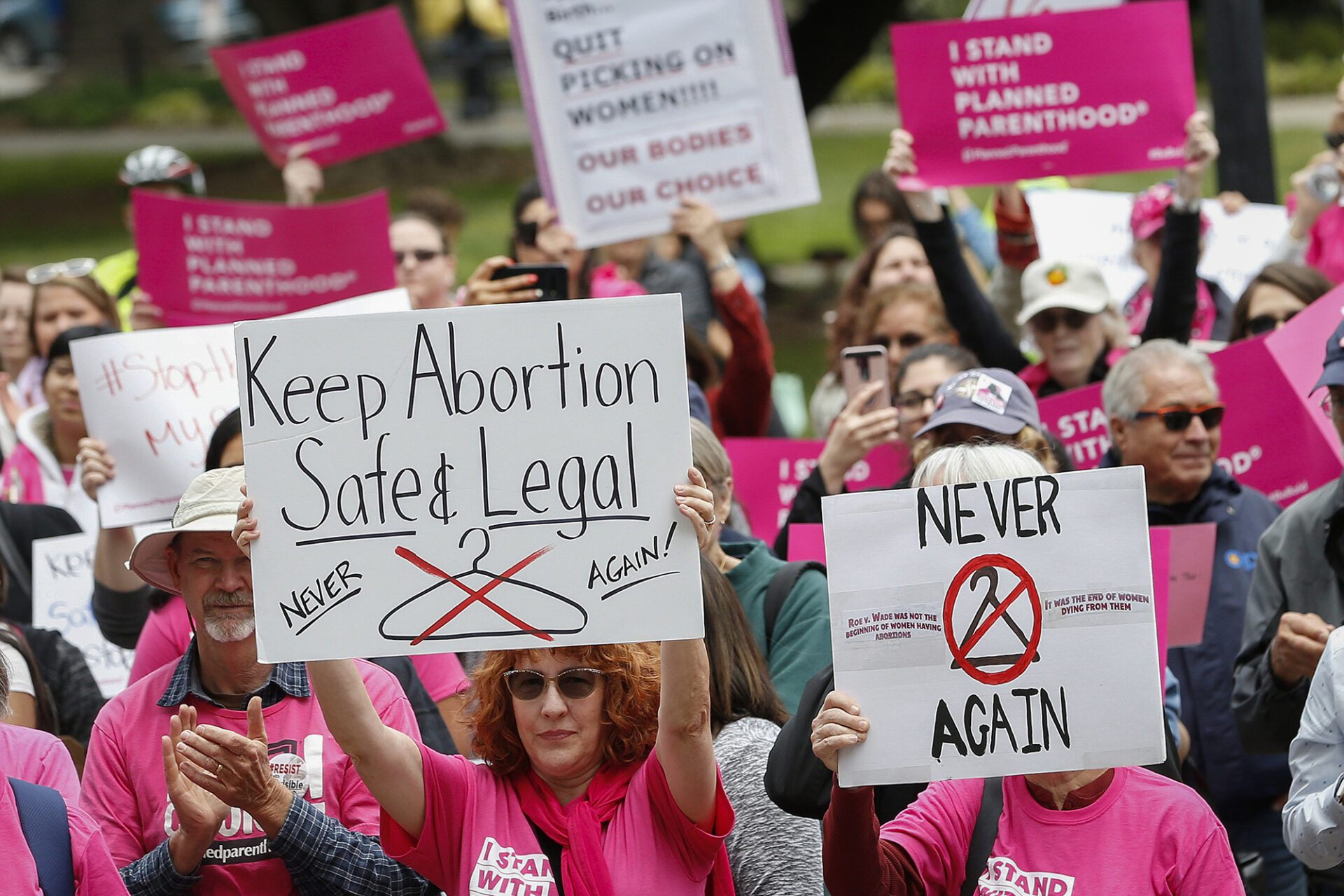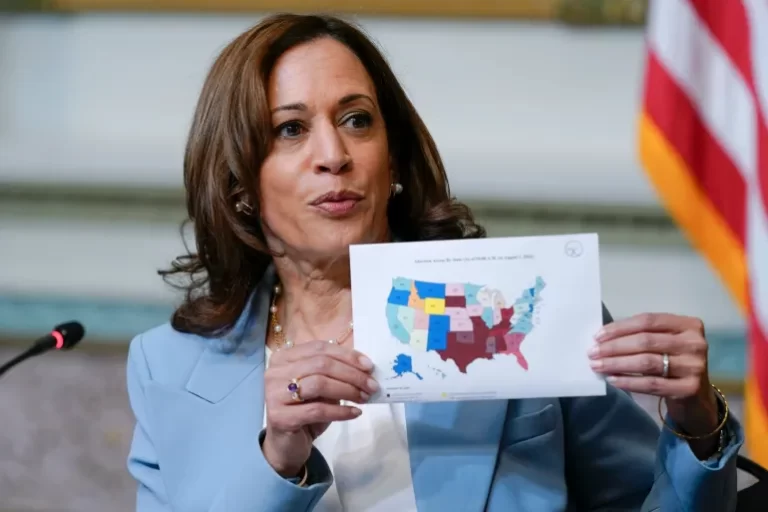At the White House, Joe Biden vowed Friday to use his power as US president to protect women’s right to abortion. Just a few blocks away, Claire, a 20-year-old student, joined thousands of others in the March for Life to the Capitol and the Supreme Court to demand more restrictions on reproductive rights. “Our fight is not over. It’s more important than ever,” she said with conviction as her group of friends nodded in agreement.
Sunday marks the 50th anniversary of Roe v. Wade, which in 1973 legalized the constitutional right to abortion in the United States. It is the first anniversary since the Supreme Court overturned the landmark ruling in June. The court’s decision means that states have the power to establish their own abortion laws. This has widened the already deep divisions in the country, triggered an avalanche of legislation from both sides, and further entrenched the positions of anti-abortionists and reproductive rights activists.
“The court got Roe right 50 years ago. It was a balanced decision with broad national consensus that the majority of Americans have continued to support for the last 50 years. And it was a constitutional principle upheld by justices appointed by Democratic and Republican presidents alike,” Biden noted in his anniversary proclamation. “I will continue to use my executive authority to protect women and families from harm in the wake of the Dobbs decision.”
Biden was referring to the Supreme Court’s June ruling on Dobbs v. Jackson Women’s Health Organization. The abortion clinic filed a lawsuit against the state of Mississippi over its 2018 law that banned nearly all abortions after 15 weeks of pregnancy. But it lost the case, with the conservative-led court overturning Roe v. Wade in a 6-3 ruling. The ruling did not come as a surprise: a draft majority opinion had been leaked to the press two months earlier, an unprecedented leak that is still being investigated.
But the ruling did trigger widespread protests. According to polls, most Americans support the right to abortion. A Pew Center poll last year found that 62% of adults living in the country believe abortion should be legal, compared to 36% who believe it should be illegal in all or most circumstances.
The ruling also had political consequences. Many female voters, angry at the court’s decision, swung in favor of the Democratic Party in the November midterm elections. The Democratic Party did better than expected at the vote. It consolidated its control of the Senate and only lost the House of Representatives, currently in Republican hands, by a handful of seats.
After the Supreme Court overturned Roe vs Wade, many Republican-controlled states passed legislation that bans abortion in nearly all cases. Alabama, Arkansas, Idaho, Oklahoma and West Virginia, are some of the states that have restricted the right to abortion. Legal challenges are pending against several of those bans.
Other Republican-controlled states banned abortion outright. Elective abortions are unavailable in Wisconsin, due to legal uncertainties faced by abortion clinics, and in North Dakota, the lone clinic relocated to Minnesota.
But the Supreme Court ruling also triggered backlash. States such as California, Vermont and Michigan voted in the November midterm elections to shield women’s reproductive rights in the state constitution. Kentucky, and a few months earlier, Kansas, rejected constitutional amendments that would have declared there is no right to abortion. This month, the South Carolina Supreme Court overturned the state’s ban on abortion after around six weeks of pregnancy, arguing that it violates the right to privacy.
“Many states have passed near-total bans on abortion with very limited exceptions or banned the procedure early in pregnancy. Courts have blocked some of these bans from taking effect, ushering in a chaotic legal landscape that is disruptive for providers trying to offer care and patients trying to obtain it,” said Elizabeth Nash and Isabel Guarnieri, from the reproductive rights organization Guttmacher Institute, in a press release last week.
In the face of this uncertainty, some states, such as New York, rushed to declare themselves sanctuary states for abortion, announcing measures to help women from states where abortion is restricted or banned. But reproductive rights activists point out that traveling to another state is not a viable solution for many women, as they cannot afford the cost of travel and accommodation.
“Millions of people are being denied the right to bodily autonomy and access to critical health care,” note the Guttmacher staffers. “When people do not have access to abortion care in their state, they are forced to make the difficult decision to travel long distances for care, self-manage an abortion or carry an unwanted pregnancy to term.”
Reproductive rights advocates in the US have been trying to find solutions. Planned Parenthood, for example, has begun to launch mobile abortion clinics to meet patients near the borders of restrictive states.
On the federal side, the government has also been trying to protect reproductive rights. As of this month, retail pharmacies can sell abortion pills thanks to a regulatory change made by the Food and Drug Administration (FDA). US Vice President Kamala Harris is also scheduled to give a speech in Florida on Sunday to reaffirm her government’s commitment to defending reproductive rights.
But while the White House may want to protect abortion rights, it has limited power to do so: pro-choice legislation has no chance of getting through the Republican-controlled House of Representatives. But the opposite is also true: a national abortion ban or tougher measures on reproductive rights would not be passed by the Democratic-controlled Senate.
That hasn’t stopped pro-lifers from trying. Marjorie Dannelfelser, the president of Susan B. Anthony Pro-Life America (SBA), is lobbying for a “federal minimum standard” on abortion. Under this proposal, the cutoff line would be set at 13 weeks of pregnancy, after which time, abortion would not be allowed in any state. And states could impose even stricter limits if they wanted to.
The anti-abortion movement, still triumphant after the Supreme Court’s decision, wants to take its agenda even further. But there is no consensus yet on the next steps to take. At the beginning of Friday’s March for Life rally, Jeanne Mancini, one of the organizers, told the crowds they needed to consider “where, we as a movement, need to focus our effort as we enter this new era in our quest to protect life.”
Meanwhile, abortion rights are shaping up to the hot-button issue in next year’s presidential election. Dannenfelser, from SBA, warned that any White House candidate perceived as being soft on the issue will have “disqualified him or herself as a presidential candidate in our eyes, and having done so has very little chance of winning the nomination.”
Source : El Pais







